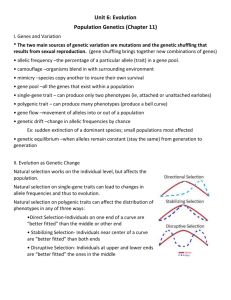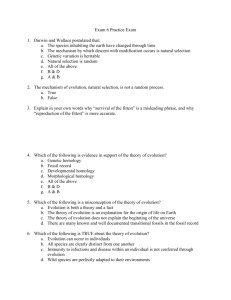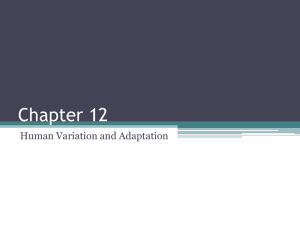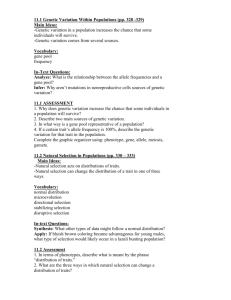Chapter 11 Reading
advertisement
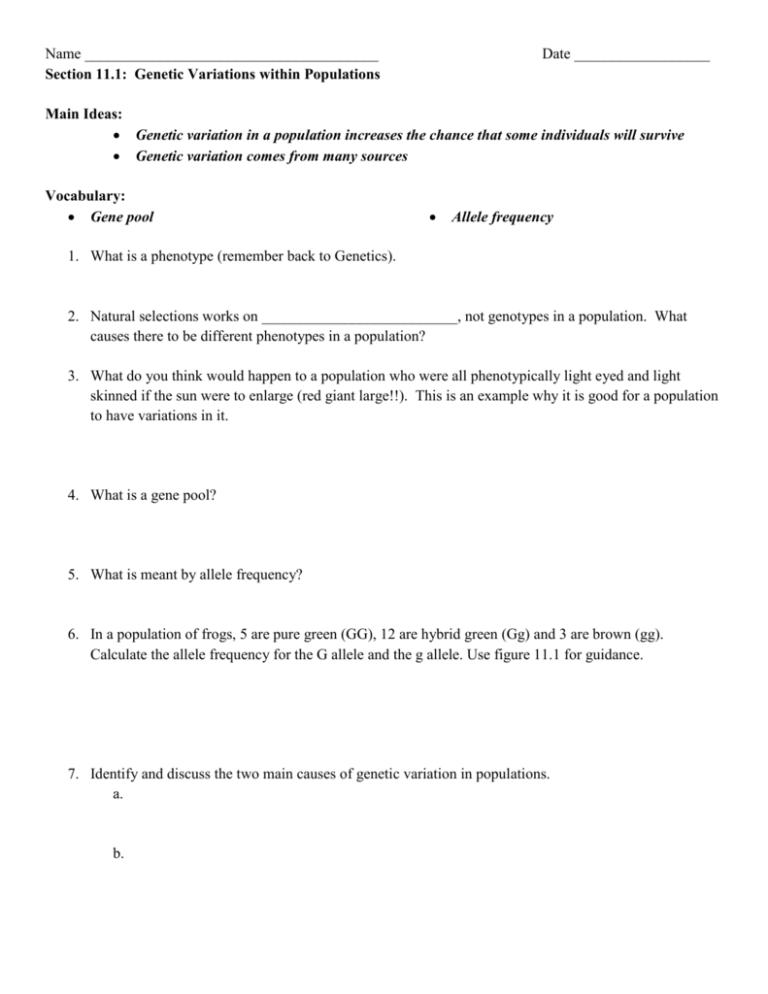
Name _______________________________________ Section 11.1: Genetic Variations within Populations Date __________________ Main Ideas: Genetic variation in a population increases the chance that some individuals will survive Genetic variation comes from many sources Vocabulary: Gene pool Allele frequency 1. What is a phenotype (remember back to Genetics). 2. Natural selections works on __________________________, not genotypes in a population. What causes there to be different phenotypes in a population? 3. What do you think would happen to a population who were all phenotypically light eyed and light skinned if the sun were to enlarge (red giant large!!). This is an example why it is good for a population to have variations in it. 4. What is a gene pool? 5. What is meant by allele frequency? 6. In a population of frogs, 5 are pure green (GG), 12 are hybrid green (Gg) and 3 are brown (gg). Calculate the allele frequency for the G allele and the g allele. Use figure 11.1 for guidance. 7. Identify and discuss the two main causes of genetic variation in populations. a. b. Section 11.3: Other Mechanisms of Evolution Main Ideas: Gene flow is the movement of alleles between populations Genetic drift is a change in allele frequencies due to chance Sexual selection occurs when certain traits increase mating success Vocabulary: Gene flow Genetic drift Bottleneck effect Sexual selection 1. Look at figure 11.7. What happened to the hatchling eagles during their first summer? 2. What does the above do to the alleles in a population’s gene pool? 3. What is meant by gene flow? 4. When your families moved from their native country, did they contribute to the gene pool of their new community? 5. What does gene flow do for the receiving population? 6. What does a lack of gene flow do to a population? 7. Observe the diagram below of frogs on a road. A car accidently rain over the group of frogs circled. In the following generations, there will no longer be green frogs. Was this due to natural selection? 8. What is genetic drift? 9. What is the bottleneck effect? 10. Give an example of the bottleneck effect. 11. How does the image below illustrate the bottleneck effect? 12. Why isn’t the male’s sperm “that valuable”? 13. Why are the female’s eggs, so valuable? 14. What is sexual selection? 15. Why would a female frigate bird be interested in the male shown in figure 11.9? Section 11. 5: Speciation through Isolation Main Ideas: The isolation of populations can lead to the formation of a new species Populations can become isolated in several ways Vocabulary: Reproductive isolation Speciation Behavioral isolation Geographic isolation 1. If there is a lot of gene flow between populations, the ______________ similar the two populations become 2. If there is less gene flow between populations, the ______________ similar the two populations become. 3. What if there is no gene flow at all between populations? What will result? 4. What is reproductive isolation? 5. What does reproductive isolation lead to? __________________ Define this term. 6. If one species of iguana had bobbing their head up and down courtship ritual and another species of iguana had a turning in circles ritual, would these two mate with each other? Why or why not? 7. What is behavioral isolation? 8. What would a river cutting through an area do to the population of beetles shown below? Section 11.6: Patterns in Evolution Main Ideas: Evolution through natural selection is not random Species can shape each other over time Species can become extinct Speciation often occurs in patterns Vocabulary: Convergent evolution Divergent evolution Coevolution Extinction Punctualed equilibrium Adaptive radiation 1. A dolphin and a shark are shaped very much alike though they are very distantly related to each other. Why are they shaped so much alike? 2. What is convergent evolution? 3. Homologous or Analogous structures (circle one) are found on organisms that demonstrate convergent evolution. 4. What occurs during divergent evolution? 5. The red fox and the kit fox both evolved from a common ancestor. What is the habitat of the red fox and how is the red fox better adapted to its environment? 6. How about the kit fox and its environment? 7. Look at Figure 11.16. Discuss the relationship between ants and the acacia plant. 8. What is coevolution? 9. What do you think will happen in future generations of crabs and snails as illustrated on the bottom of page 349? 10. Define extinction and explain why some species go extinct. 11. What is punctuated equilibrium (illustrated below) as it relates to the rate of speciation? 12. Darwin used the beaks of finches on the Galapagos Islands as a great example of adaptive radiation. What is adaptive radiation (illustrated by the Galapagos finch beaks shown below)?
